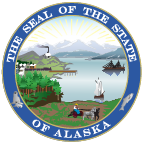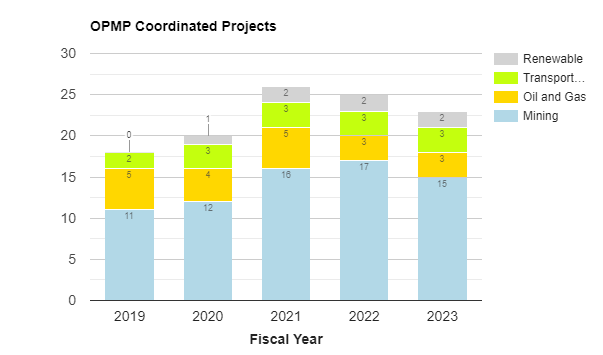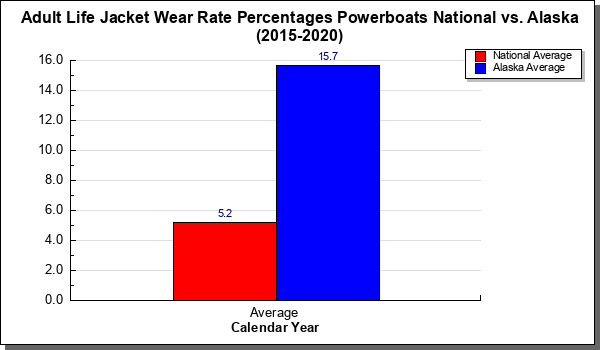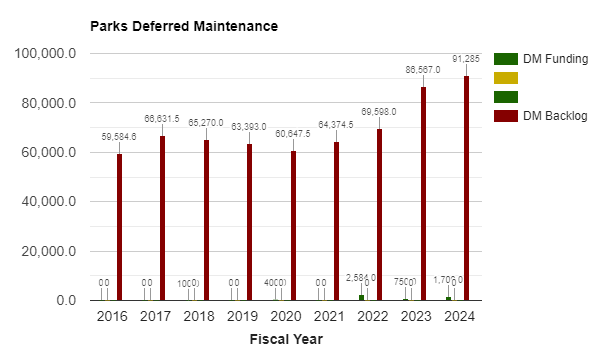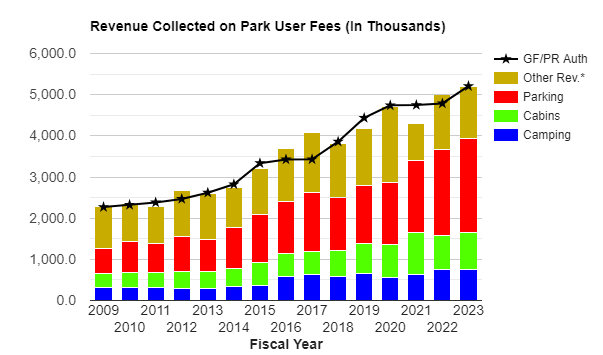Key Performance Indicators
Department of Natural Resources
Mission
Develop, conserve and maximize the use of Alaska's natural resources consistent with the public interest. Alaska Constitution Article 8; Alaska Statute (AS) 03, AS 27, AS 38, AS 40, AS 41, AS 43.90, AS 14.30.740
Key Performance Indicators
| FY2024 Management Plan as of 04/24/2024 (in thousands) | |||||||||
| Department of Natural Resources Totals | Funding | Positions | |||||||
| UGF Funds | DGF Funds | Other Funds | Federal Funds | Total Funds | Full Time | Part Time | Non Perm | ||
| $73,353.7 | $43,890.1 | $41,307.4 | $38,930.9 | $197,482.1 | 738 | 234 | 73 | ||
| 2: |
Mitigate threat to the public from natural hazards by providing comprehensive fire protection services on state, private and municipal lands, and through identifying significant geologic hazards.
|
Funding | Positions | ||||||
|
UGF Funds |
DGF Funds |
Other Funds |
Federal Funds |
Total Funds |
Full Time |
Part Time |
Non Perm |
||
| $38,112.9 | $733.3 | $4,018.1 | $25,822.3 | $68,686.7 | 93 | 187 | 2 | ||
- Target: Publish reports or maps providing improved assessment of geologic hazards that could pose significant risks to public safety or infrastructure.
- Target: Contain more than 90% of wildland fires at less than 10 acres within Alaska"s heavily populated areas (Critical and Full Management Options) in accordance with the Alaska Interagency Wildland Fire Management Plan.
- Target: Provide wildland fire training to agency personnel, fire departments, and urban and rural communities.
- Target: Fill the firefighting needs for the average fire season with Alaskan firefighters.
- Target: Provide safe, cost effective wildland fire protection services to the State of Alaska.
- Target: Reduce the impact of wildfire smoke on the public by working to mitigate smoke concerns from fires near communities.
- Target: Minimize lost work days for firefighters.
| 3: |
Provide access to state lands for public and private use, settlement, and recreation.
|
Funding | Positions | ||||||
|
UGF Funds |
DGF Funds |
Other Funds |
Federal Funds |
Total Funds |
Full Time |
Part Time |
Non Perm |
||
| $5,442.1 | $20,409.9 | $5,659.0 | $2,635.2 | $34,146.1 | 196 | 19 | 53 | ||
- Target: Process a minimum of 80% of land use applications received.
- Target: Process a minimum of 90% of new water use applications received.
- Target: Provide accessible, clean, safe, and well-maintained park facilities for Alaska residents and visitors by reducing deferred maintenance needs in park units.
- Target: Collect fees necessary to reach authorized program receipt funds in the Parks Management and Access budget; annually evaluate and if necessary, raise fees in order to reach program receipts authorization.
| 4: |
Ensure sufficient data acquisition and assessment of land and resources to foster responsible resource and community development and public safety.
|
Funding | Positions | ||||||
|
UGF Funds |
DGF Funds |
Other Funds |
Federal Funds |
Total Funds |
Full Time |
Part Time |
Non Perm |
||
| $7,233.8 | $4,367.3 | $5,894.1 | $3,929.1 | $21,424.3 | 107 | 12 | 5 | ||
- Target: Publish airborne geophysical survey data for Alaska"s minerals-interest lands.
- Target: Publish reports on energy-related geology that assist the energy industry and state agencies in exploring for and managing energy resources on state-interest lands.
Performance Detail
| Priority 1: Foster responsible commercial development and use of state land and natural resources, consistent with the public interest, for long-term wealth and employment. |
Target #1: Provide Alaskan firms in Southern Southeast Alaska with the maximum volume of state timber sustainably available..
Ketchikan continues to be the division"s highest revenue producing office. DOF is utilizing a housing stipend and retention bonus in an effort to attract candidates to vacant positions in Ketchikan. These positions have had high turnover rates and are challenging to fill. The Ketchikan office continues to leverage contractor and industry partnerships to assist in sale planning and development. The Ketchikan area office sold three timber sales in Southern Southeast Alaska in FY22 for a total of 4,772 thousand board feet (MBF). Three more timber sales on state land are currently under development, and are scheduled to be offered before the end of Calendar Year 2022. Most of the timber sold in 2021 came from the 15,000 MBF Bay View Timber Sale, which encompassed both State Forest and Settlement lands. Coordinating with the Division of Mining, Land and Water and the Thorne Bay community about the subdivision that would be located in the timber sale area required significant staff time, resulting in lower sales in 2020. Through Good Neighbor Agreements with the US Forest Service, DOF is currently administering the contracts on 32,000 MBF of timber on two separate timber sales on USFS lands. Target Last Modified: 11/07/2023 |
Target #2: Offer 200 parcels of land at auction..
NOTE: In calendar year 2013, the annual auction was moved from June 2013 to July 2014, which accounts for the fact that there was no auction in 2013. In addition, hundreds of "lost parcels" were found and offered in FY2012 and a special discount auction was offered in FY2014, accounting for the high parcel numbers in FY2012 and FY2014. On a calendar year basis, the number of sales is consistent. However, due to an auction occurring a few days prior to the end of FY2020, the results show an increase to FY2020 and a decrease to FY2021. Current fiscal year is on track for normal sales. Target Last Modified: 11/08/2023 |
Target #3: Facilitate and improve regulatory and lease compliance monitoring of AS.38.35 pipelines..
The Pipeline Section (SPS) generally applies a systematic approach to lease compliance inspections based on lessee annual reports and proposed work plans. Each field inspection is conducted according to a project mission developed around lease stipulations and the lessee"s work plans and maintenance activities, or other lease related actions such as amendments, releases of interest, and renewals. Starting in FY 2019, the SPS implemented a Geospatial Information System (GIS) platform that was utilized for gathering field data and pipeline system data while conducting inspections, thus changing some of the metrics originally collected. Additionally, inspections, permit applications, and surveillances were minimized between FY20 and FY21 due to COVID-19 restrictions implemented by lessees and industry, and long-term vacancies in the SPS. Oversight and regulatory actions of pipelines shifted from predominantly fieldwork to remote coordination and digital information sharing. At that time, industry reprioritized routine maintenance of pipelines during COVID-19 restrictions to restrict work that was critical to the safety, environment and integrity of pipelines and deferred routine maintenance to later. During these years, the SPS saw fewer permit applications. In FY22, the SPS has observed activity, including field surveillances and permit applications, more consistent with pre-COVID-19 activities. This is reflected in the metrics of FY22. The metrics provided in this report capture the previous years prior to and during these inconsistencies. In FY23, the SPS has observed activity, including field surveillances and permit applications similar to pre-COVID-19 activities. The metrics provided in this report indicate a decrease from FY22, however, this is due to a change in internal reporting. Target Last Modified: 11/02/2023 |
Target #4: Coordinate the review, permitting, and monitoring of natural and renewable resource development, transportation, and other specialized projects consistent with the missions of the department and participating state agencies..
The number and types of projects coordinated by OPMP annually indicates relative demand for the program; it also provides OPMP insight into industry and market trends in Alaska. For example, the 33 percent increase in coordinated mineral projects from FY2020 to FY2021 reflects increased mineral exploration activities driven in part by strong mineral prices. While the number of coordinated projects has decreased slightly, OPMP anticipates an upward trend in the near-term (1-2 years) due to positive economic trends within industries and growing interest in: critical and strategic minerals sourced domestically, alternative energy source development, as well as funding for broadband. OPMP"s principal challenge for providing permit coordination is maintaining sufficient organizational capacity (i.e. staffing, training, expertise, budget resources, etc.) to adjust to fluctuations in coordinated project workloads and deliver timely, coordinated project reviews. Such workload fluctuations are often driven by factors outside OPMP"s control (i.e. economic conditions, regulatory changes, commodity process, investment trends, available funding, etc.), but are an important metric used to gauge relative demand for large project coordination services. Related links: Target Last Modified: 11/08/2023 |
Target #5: Provide stable or increasing economic benefit from the use of trees and forests on state land by selling state timber to twenty or more Alaskan businesses..
Target Last Modified: 03/29/2023 |
Target #6: Increase awareness of Alaska Grown products and market options, and expand gross farm product sales..
The data provided comes from surveys conducted throughout the year by the USDA National Agricultural Statistics Services. Core services continue to demonstrate growth in monetary value of Alaska agricultural products sold. Target Last Modified: 03/29/2023 |
Target #7: Operate the Forest Resources and Practices Act program to achieve 100% implementation of Best Management Practices (BMPs)..
Target Last Modified: 11/07/2023 |
Target #8: Promote safer boating behaviors on Alaska"s waters..
Target Last Modified: 03/29/2023 |
| Priority 2: Mitigate threat to the public from natural hazards by providing comprehensive fire protection services on state, private and municipal lands, and through identifying significant geologic hazards. |
Target #1: Publish reports or maps providing improved assessment of geologic hazards that could pose significant risks to public safety or infrastructure..
The Hydrology & Surficial Geology Section published two hazards-related reports in FY2023, which included a sonar and seismic lake survey, as well as a profile and discharge data study for an area of the North Slope between Wainwright, Asqausk and Utqiagvik and a lidar elevation datasets—between Utqiagvik and Atqasuk, The Geologic Hazards Section published 10 hazards-related DGGS reports and datasets in FY2023, including three lidar datasets, two ortho-images with accompanying photogrammetry-derived elevation datasets, two coastal hazards reports (coastal bluff erosion assessment for Homer, community impacts from Extra-Tropical Cyclone Merbok), two tsunami inundation reports (including Seward, northern Resurrection Bay, Karluk, Larsen Bay, and Kodiak Island), and a guidebook to permafrost and Quaternary geology of the Fairbanks area. Fewer publications were produced in FY23 due to staff turnover and retirement, including the former section chief and Coastal Hazards Program manager. We expect publication numbers to increase to former levels once these programs rebuild their capacity. The Volcanology Section, working in conjunction with federal U.S. Geological Survey (USGS) and University of Alaska Fairbanks partners, published five volcano-hazard related reports and datasets in FY2023, including briefing information on volcanic unrest at Mount Edgecumbe, near the community of Sitka, comprehensive reports on all volcanic activity in Alaska for the years 2018 and 2019, and electron microprobe data on rocks and minerals from recent Pavlof eruptions. Related links: Target Last Modified: 11/08/2023 |
Target #2: Contain more than 90% of wildland fires at less than 10 acres within Alaska"s heavily populated areas (Critical and Full Management Options) in accordance with the Alaska Interagency Wildland Fire Management Plan..
One of DOF`s key goals is to contain 90% of wildland fires at less than 10 acres within Critical and Full management option areas. In 2023, 100% of the 133 fires in “Critical” were contained at under 10 acres, though only 45 out of 66, or a below average 68% of fires within “Full” were contained at less than 10 acres, as has been the trend over the last 10 years. After a slow start to fire season,on July 24 storm systems generated over 18,000 lightning strikes in the Interior, leading to 30 new fires within 24 hours. By the end of August, 343 fires had burned close to 300,000 acres. Of the 343 total fires in Alaska,168 were human caused and 175 were natural, or lightning, starts. The string of lightning fires that started after July 24 accounts for the majority of the 21 fires that exceeded 10 acres in the “Full” management option, though there were also two coal seam fires which did not receive initial action due to firefighter risk. The number of fires during the week of July 24 overwhelmed initial attack capabilities, primarily due to a shortage of ground-based firefighters, and DOF had to prioritize initial action on fires that had the highest potential of threatening values. Target Last Modified: 11/07/2023 |
Target #3: Provide wildland fire training to agency personnel, fire departments, and urban and rural communities..
DOF conducted 52 interagency classes across a range of subjects and disciplines, including mental health and emergency medical training. Extensive training is provided not only to state employees but also to cooperators such as local and federal government employees. There were over 600 cooperators, and 1100 EFF trained this year.? Online training is included in this number and remains a popular delivery method. The division hired 2 EFF entry level dispatchers to help fill basic personnel needs and provide training and employment opportunities. The five-person LTNP Helitack module was rehired in McGrath, providing the area with additional capacity to provide helicopter supported initial attack in the area, while providing the LTNPs with valuable fire experience. DOF hosted five academies in 2023, with 151 cadets successfully graduating. Sessions included two basic firefighter academies in Tok and McGrath, an intermediate firefighter academy, an engine academy and DOF`s first-ever aerial supervision academy. In combination with the hazardous fuels reduction program, 92 graduates were employed on fuels crews to complete hazard mitigation projects and as initial attack firefighters. Five more academies are scheduled for 2024, with 4 focusing on wildland fire operations ranging from entry level to intermediate and a prevention academy. Related links: Target Last Modified: 11/07/2023 |
Target #4: Fill the firefighting needs for the average fire season with Alaskan firefighters..
A successful program requires a trained, experienced Alaskan firefighting workforce combined with infrastructure, equipment, and logistical support. Within DOF Fire Management Areas, there has been a consistent turnover of fire managers, Type 3 Incident Commanders, Division Supervisors as well as dispatch and aviation personnel. Recruitment and retention of a qualified firefighting force within the DOF has been challenging due to the short season of employment combined with more competitive wages and benefits in the private and Federal sectors. Department Order 017 identifies that the Department of Natural Resources, Division of Forestry provide a strong initial attack, management, and support capability to assure maximum efficiency is achieved for an average fire year based on the historical fire occurrence. As the complexity and length of the fire season increases, the need for experienced personnel to manage these fires has become even more critical. Extensive knowledge and training are necessary to make timely decisions about strategy and tactics. This is more critical as the urban interface environment and the responsibilities to protect lives, homes and communities continues to grow. Related links: Target Last Modified: 11/07/2023 |
Target #5: Provide safe, cost effective wildland fire protection services to the State of Alaska..
Modified" management option is treated as "Full" earlier in the season when fires have a greater potential for growth and after management evaluation around July 10th, they are converted and treated as "Limited". These management options are meant as an initial guide only, and agency administrators may alter the response based on resource availablity, values at risk, safety, ecological benefit or cost concerns. Unusually cool and damp weather in the early season created a very slow start to the Alaskan fire season, with a record low of fewer than 2,000 acres burned within the State before July 15. In late July a high-pressure system set up over the northern half of the state, creating an extended period of hot and dry conditions in the Fairbanks, Delta and Tok Areas. On July 24, storm systems generated over 18,000 lightning strikes in the Interior, leading to 30 new fires within 24 hours. By the end of August, 343 fires had burned close to 300,000 acres. Of the 343 total fires in Alaska,168 were human caused and 175 were natural, or lightning, starts. The string of lightning fires that started after July 24 accounts for the majority of the 21 fires that exceeded 10 acres in the “Full” management option, though there were also two coal seam fires which did not receive initial action due to firefighter risk. The number of fires during the week of July 24 overwhelmed initial attack capabilities, primarily due to a shortage of ground-based firefighters, and DOF had to prioritize initial action on fires that had the highest potential of threatening values. Related links: Target Last Modified: 11/07/2023 |
Target #6: Reduce the impact of wildfire smoke on the public by working to mitigate smoke concerns from fires near communities..
DEC issued seventeen wildfire related air quality advisories in 2023, though the majority were advisories for smoke impacting Alaska from fires occuring in western Canada. On July 30th, the first of several advisories for Alaskan fires were issued for central and eastern Alaska due to the 30+ new starts. Air quality in eastern interior communities such as Delta Junction and Tok were poor to hazardous in late July and early August. A series of fires near Nenana caused poor air quality in communites such as Clear, Anderson and Nenana. Fires in the Tanana Valley had potential to affect Fairbanks, but wind patterns kept smoke out of the larger community for most of the summer. Related links: Target Last Modified: 11/07/2023 |
Target #7: Minimize lost work days for firefighters..
Recent trends have shown an uptick in tree-strike and chainsaw injuries on Alaskan fires. While the cause is unknown, there is a potential correlation with a decrease in the experience levels of fire personnel in recent years. Fortunately there we no critical injuries in 2023, but there were a several serious injuries including two tree strikes, burns to a firefighters hand and arm from steam in a water handling pump, and seven chainsaw injuries including a chainsaw cut to the face (though fortunately not deep). The Alaska fire medic program has been a robust, interagency program that trains and outfits fire medics who can be mobilized to fires when needed. Fire medics are crucial in Alaska due to the remoteness of the work, and distance and time that are required to get a patient to a medical facility. The BLM/Alaska Fire Service has been the lead agency in developing the program over the years, but with a change in the BLM`s national management of medical programs, DOF is taking more responsibility for maintaining its own fire medic program into the futur Target Last Modified: 11/07/2023 |
| Priority 3: Provide access to state lands for public and private use, settlement, and recreation. |
Target #1: Process a minimum of 80% of land use applications received..
Not included in the above numbers are Interagency Land Management Assignments, Cooperative Resource Management Agreements, and trespass cases. The division supports other state agencies through the issuance of Interagency Land Management Assignments, and issues Cooperative Resource Management Agreements with municipalities or other entities. These actions require time and attention as well as adjudicatory work. Each new authorization issued creates a new workload of contract administration, assignments, amendments, name changes, sub-lease agreements, billing, monitoring, compliance and close out, all of which is not reflected in these numbers. The division expects there to be more applications in future years as the state strives to bring in additional entitlement acres with high development potential each year, as federally approved infrastructure initiatives generate new projects, and the division moves to improve tracking and resolution of previously unauthorized uses which could be legitimately permitted. The division"s stewardship responsibilities that do not involve issuing an authorization are constant. The substantial amount of time staff spends on these issues takes them away from their duties to process authorizations. Despite necessary diversion of stewardship responsibilities, policy development, increasing recruitment and retention challenges in FY2023, the number of land use authorizations issued by DMLW staff continued to exceed new applications received. In general, many types of businesses or support corporations received authorizations that allowed use of state land for financial gain, and for diversification of the state economy. Authorizations in this component benefit utility, oil and gas, mining, commercial recreation, tourism, fishing, construction, and other development industries by authorizing legal access to the state owned and managed land, water, and resources. If the division is not able to take the necessary time to produce defensible, responsible decisions which will successfully withstand appeals or litigation, these same industries are adversely affected. Often businesses cannot plan their operations, get investment capital, insurance, or loans if they do not have the required land authorizations. A few of the major projects worked by the Regional Land Offices in FY2023 include, the on-going Ambler Road Project proposed by the Alaska Industrial Development and Export Authority, the public access project for the Donlin Gold Mine and the West Su Access Road, . Received Issued Leases 41 119 Material Sale 51 47 Permits 183 371 Easements 44 54 Target Last Modified: 11/10/2023 |
Target #2: Process a minimum of 90% of new water use applications received..
The use of state water resources is primarily managed through issued water rights and temporary water use authorizations. During FY2023 a combined total of 442 new applications were received and 544 authorizations were issued, providing a 123% processing rate. The increase in the percent of applications processed is attribute to the backlog reduction project, which funds three long term non-permanent positions to processing older water right applications. Target Last Modified: 11/10/2023 |
Target #3: Provide accessible, clean, safe, and well-maintained park facilities for Alaska residents and visitors by reducing deferred maintenance needs in park units..
Target Last Modified: 11/06/2023 |
Target #4: Collect fees necessary to reach authorized program receipt funds in the Parks Management and Access budget; annually evaluate and if necessary, raise fees in order to reach program receipts authorization..
Any new investments in the division"s infrastructure will be reviewed with the idea of sustainability and revenue producing potential in mind. Investments in public use cabins, electronic fee stations, and similar infrastructure have revenue producing potential and fill a demonstrated public demand. Target Last Modified: 03/29/2023 |
| Priority 4: Ensure sufficient data acquisition and assessment of land and resources to foster responsible resource and community development and public safety. |
Target #1: Publish airborne geophysical survey data for Alaska"s minerals-interest lands..
The federal Earth MRI critical-minerals program was funded by the U.S. Congress in FFY2019, and it is anticipated to be a 10-year project to acquire airborne geophysical surveys, geologic mapping, and LiDAR over areas of the nation with critical minerals potential. Additional funds were added through the federal IIJA bill in 2022, so federal funding will be at elevated levels through 2026. DGGS has been contracted by the USGS to manage the federal geophysical contracts covering large portions of Alaska"s mineral districts. In FY2023 DGGS released 7,984 square miles of fixed-wing magnetic and radiometric data in Central Yukon-Tanana Upland and 4,741 square miles in Western Yukon-Tanana Upland, respectively. In late FY2023, DGGS initiated fixed-wing magnetic and radiometric and gravity surveying in the northeast part of the Kuskokwim River area of Southwest Alaska; these surveys are scheduled for publication in FY2024. DGGS also initiated helicopter-based geophysical surveying in this area, as well as on the Seward Peninsula; these surveys will be published in FY2024. Related links: Target Last Modified: 11/08/2023 |
Target #2: Publish reports on energy-related geology that assist the energy industry and state agencies in exploring for and managing energy resources on state-interest lands..
DGGS fell short of the target number of energy reports due a redirection of section activities for much of the fiscal year, with a focus on three new efforts: 1) A large investment of staff time was spent on logistics, contracting, and permitting for a major ASTART-funded coring project on the North Slope with the USGS, 2) the section assumed a lead technical role in the CORE-CM project, resulting in substantial stakeholder work and the uploading of new geochemical data to a community EDX database, and 3) the energy group participated in the carbon capture, utilization, and sequestration (CCUS) statewide working groups, as well as contributing to two major U.S. Department of Energy grant applications. The energy section was further challenged by staff turnover and recruitment challenges. Related links: Target Last Modified: 11/08/2023 |
Last refreshed: 04/24/2024 05:00 pm
